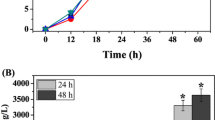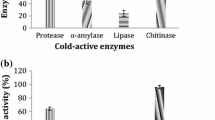Abstract
Cordycepin is a major bioactive compound found in Cordyceps sinensis that exhibits a broad spectrum of biological activities. Here a Paecilomyces hepiali OR-1 strain was initially isolated from plateau soil for the bioproduction of cordycepin. Subsequently, strain modification including 60Co γ-ray and ultraviolet irradiation were employed to increase the cordycepin titer, resulted in a high-yield mutant strain P. hepiali ZJB18001 with the cordycepin content of 0.61 mg/gDCW, showing a 2.3-fold to that from the wild strain (0.26 mg/gDCW). Furthermore, medium screening based on Box-Behnken design and the response surface methodology facilitated the enhancement of cordycepin yield to the value of 0.96 mg/gDCW at 25 °C for 5 days in submerged cultivation with an optimized medium composition. The high cordycepin yield, rapid growth rate and stable genetic characteristics of P. hepiali ZJB18001 are beneficial in terms of costs and time for the industrialization of cordycepin production.








Similar content being viewed by others
References
Verma AK (2020) Cordycepin: a bioactive metabolite of Cordyceps militaris and polyadenylation inhibitor with therapeutic potential against COVID-19. J Biomol Struct Dyn. https://doi.org/10.1080/07391102.2020.1850352
Lin LT, Lai YJ, Wu SC, Hsu WH, Tai CJ (2018) Optimal conditions for cordycepin production in surface liquid-cultured Cordyceps militaris treated with porcine liver extracts for suppression of oral cancer. J Food Drug Anal 26(1):135–144. https://doi.org/10.1016/j.jfda.2016.11.021
Lee CT, Huang KS, Shaw JF, Chen JR, Kuo WS, Shen G, Grumezescu AM, Holban AM, Wang YT, Wang JS, Hsiang YP, Lin YM, Hsu HH, Yang CH (2020) Trends in the immunomodulatory effects of Cordyceps militaris: total extracts, polysaccharides and cordycepin. Front Pharmacol 11:575704. https://doi.org/10.3389/fphar.2020.575704
Kunhorm P, Chaicharoenaudomrung N, Noisa P (2019) Enrichment of cordycepin for cosmeceutical applications: culture systems and strategies. Appl Microbiol Biotechnol 103:1681–1691. https://doi.org/10.1007/s00253-019-09623-3
Cui JD (2015) Biotechnological production and applications of Cordyceps militaris, a valued traditional Chinese medicine. Crit Rev Biotechnol 35(4):475–484. https://doi.org/10.3109/07388551.2014.900604
Sari N, Suparmin A, Kato T, Park EY (2016) Improved cordycepin production in a liquid surface culture of Cordyceps militaris isolated from wild strain. Biotechnol Bioprocess Eng 21:595–600. https://doi.org/10.1007/s12257-016-0405-0
Tang J, Liu Y, Zhu L (2014) Optimization of fermentation conditions and purification of cordycepin from Cordyceps militaris. Prep Biochem Biotechnol 44(1):90–106. https://doi.org/10.1080/10826068.2013.833111
Chang CY, Lue MY, Pan TM (2005) Determination of adenosine, cordycepin and ergosterol contents in cultivated Antrodia camphorata by HPLC method. J Food Drug Anal 13(4):338–342. https://doi.org/10.38212/2224-6614.2569
Yang L, Li G, Chai Z, Gong Q, Guo J (2020) Synthesis of cordycepin: current scenario and future perspectives. Fungal Genet Biol 143:103431. https://doi.org/10.1016/j.fgb.2020.103431
Zou SP, Zhong W, Xia CJ, Gu YN, Niu K, Zheng YG, Shen YC (2015) Mutagenesis breeding of high echinocandin B producing strain and further titer improvement with culture medium optimization. Bioprocess Biosyst Eng 38(10):1845–1854. https://doi.org/10.1007/s00449-015-1425-4
Liu P, Yuan J, Jiang Z, Wang Y, Weng B, Li G (2019) A lower cadmium accumulating strain of Agaricus brasiliensis produced by 60Co-γ-irradiation. Lwt-Food Sci Technol 114:108370. https://doi.org/10.1016/j.lwt.2019.108370
Das SK, Masuda M, Hatashita M, Sakurai A, Sakakibara M (2008) A new approach for improving cordycepin productivity in surface liquid culture of Cordyceps militaris using high-energy ion beam irradiation. Lett Appl Microbiol 47(6):534–538. https://doi.org/10.1111/j.1472-765X.2008.02456.x
Masuda M, Das SK, Fujihara S, Hatashita M, Sakurai A (2011) Production of cordycepin by a repeated batch culture of a Cordyceps militaris mutant obtained by proton beam irradiation. J Biosci Bioeng 111(1):55–60. https://doi.org/10.1016/j.jbiosc.2010.08.018
Masuda M, Das SK, Hatashita M, Fujihara S, Sakurai A (2014) Efficient production of cordycepin by the Cordyceps militaris mutant G81–3 for practical use. Process Biochem 49(2):181–187. https://doi.org/10.1016/j.procbio.2013.10.017
Lee SK, Lee JH, Kim HR, Chun Y, Lee JH, Yoo HY, Park C, Kim SW (2019) Improved cordycepin production by Cordyceps militaris KYL05 using casein hydrolysate in submerged conditions. Biomolecules 9(9):461. https://doi.org/10.3390/biom9090461
Kalil SJ, Maugeri F, Rodrigues MI (2000) Response surface analysis and simulation as a tool for bioprocess design and optimization. Process Biochem 35(6):539–550. https://doi.org/10.1016/S0032-9592(99)00101-6
Chaudhary P, Chhokar V, Choudhary P, Kumar A, Beniwal V (2017) Optimization of chromium and tannic acid bioremediation by Aspergillus niveus using Plackett-Burman design and response surface methodology. AMB Express 7:201. https://doi.org/10.1186/s13568-017-0504-0
Kaushik V, Singh A, Arya A, Sindhu SC, Sindhu A, Singh A (2020) Enhanced production of cordycepin in Ophiocordyceps sinensis using growth supplements under submerged conditions. Biotechnol Reports 28:e00557. https://doi.org/10.1016/j.btre.2020.e00557
Tang J, Qian Z, Wu H (2018) Enhancing cordycepin production in liquid static cultivation of Cordyceps militaris by adding vegetable oils as the secondary carbon source. Bioresour Technol 268:60–67. https://doi.org/10.1016/j.biortech.2018.07.128
Abrusci C, Martín-González A, Del Amo A, Catalina F, Collado J, Platas G (2005) Isolation and identification of bacteria and fungi from cinematographic films. Int Biodeterior Biodegrad 56(1):58–68. https://doi.org/10.1016/j.ibiod.2005.05.004
Liu ZQ, Li Y, Ping LF, Xu YY, Cui FJ, Xue YP, Zheng YG (2007) Isolation and identification of a novel Rhodococcus sp. ML-0004 producing epoxide hydrolase and optimization of enzyme production. Process Biochem 42(5):889–894. https://doi.org/10.1016/j.procbio.2007.01.009
Lee HH, Kang N, Park I, Park J, Kim I, Kim J, Kim N, Lee JY, Seo YS (2017) Characterization of newly bred Cordyceps militaris strains for higher production of cordycepin through HPLC and URP-PCR analysis. J Microbiol Biotechnol 27(7):1223–1232. https://doi.org/10.4014/jmb.1701.01043
Ye Z, Wang W, Yuan Q, Ye H, Sun Y, Zhang H, Zeng X (2016) Box-Behnken design for extraction optimization, characterization and in vitro antioxidant activity of Cicer arietinum L. hull polysaccharides. Carbohydr Polym 147:354–364. https://doi.org/10.1016/j.carbpol.2016.03.092
Takaku H, Ebina S, Kasuga K, Sato R, Ara S, Kazama H, Matsuzawa T, Yaoi K, Araki H, Shida Y, Ogasawara W, Ishiya K, Aburatani S, Yamazaki H (2021) Isolation and characterization of Lipomyces starkeyi mutants with greatly increased lipid productivity following UV irradiation. J Biosci Bioeng 131(6):613–621. https://doi.org/10.1016/j.jbiosc.2021.01.006
Kang CK, Yang JE, Park HW, Choi YJ (2021) Enhanced lycopene production by UV-C irradiation in radiation-resistant Deinococcus radiodurans R1. J Microbiol Biotechn 30(12):1937–1943. https://doi.org/10.4014/jmb.2009.09013
Cui JD, Zhang YN (2012) Evaluation of metal ions and surfactants effect on cell growth and exopolysaccharide production in two-stage submerged culture of Cordyceps militaris. Appl Biochem Biotechnol 168(6):1394–1404. https://doi.org/10.1007/s12010-012-9865-7
Lin S, Liu ZQ, Xue YP, Baker PJ, Wu H, Xu F, Teng Y, Brathwaite ME, Zheng YG (2016) Biosynthetic pathway analysis for improving the cordycepin and cordycepic acid production in Hirsutella sinensis. Appl Biochem Biotechnol 179:633–649. https://doi.org/10.1007/s12010-016-2020-0
Pang F, Wang L, Jin Y, Guo L, Song L, Liu G, Feng C (2018) Transcriptome analysis of Paecilomyces hepiali at different growth stages and culture additives to reveal putative genes in cordycepin biosynthesis. Genomics 110(3):162–170. https://doi.org/10.1016/j.ygeno.2017.09.008
Xia Y, Luo F, Shang Y, Chen P, Lu Y, Wang C (2017) Fungal cordycepin biosynthesis is coupled with the production of the safeguard molecule pentostatin. Cell Chem Biol 24(12):1479–1489. https://doi.org/10.1016/j.chembiol.2017.09.001
Jin LQ, Xu ZW, Men XH, Zhang B, Liu ZQ, Zheng YG (2020) Enhancement of protoplast preparation and regeneration of Hirsutella sinensis based on process optimization. Biotechnol Lett 42(11):2357–2366. https://doi.org/10.1007/s10529-020-02958-2
Acknowledgements
None.
Funding
This work was financially supported by the National Natural Science Foundation of China (32070099 and 32000898), the Natural Science Foundation of Zhejiang Province (LQ21B060006), the Fundamental Research Funds for the Provincial Universities of Zhejiang (RF-C2019005).
Author information
Authors and Affiliations
Contributions
Xue Cai: Data curation, Writing-original draft and Writing-Review and Editing; Jie-Yi Jin: Investigation and Validation; Bo Zhang: Methodology and Writing-Review and Editing; Zhi-Qiang Liu: Conceptualization, Writing-Review and Editing; Yu-Guo Zheng: Supervision.
Corresponding author
Ethics declarations
Conflict of interest
Authors have no declarations of conflict of interest.
Additional information
Publisher's Note
Springer Nature remains neutral with regard to jurisdictional claims in published maps and institutional affiliations.
Supplementary Information
Below is the link to the electronic supplementary material.
Rights and permissions
About this article
Cite this article
Cai, X., Jin, JY., Zhang, B. et al. Improvement of cordycepin production by an isolated Paecilomyces hepiali mutant from combinatorial mutation breeding and medium screening. Bioprocess Biosyst Eng 44, 2387–2398 (2021). https://doi.org/10.1007/s00449-021-02611-w
Received:
Accepted:
Published:
Issue Date:
DOI: https://doi.org/10.1007/s00449-021-02611-w




